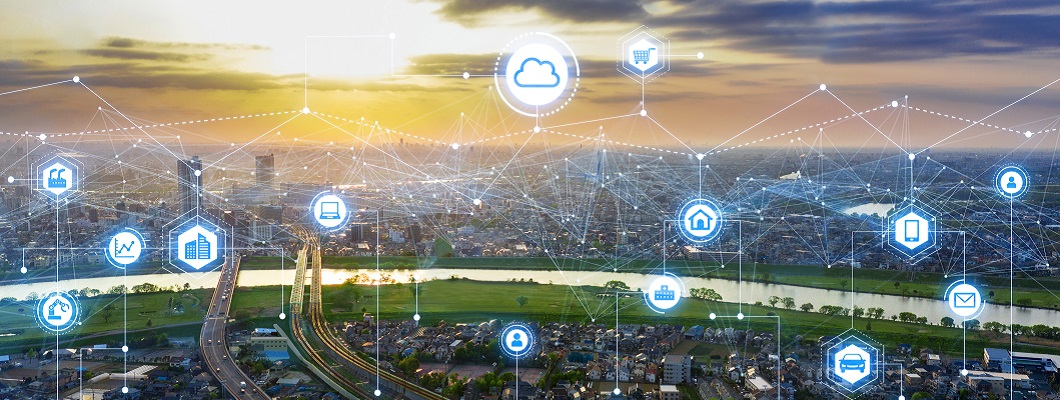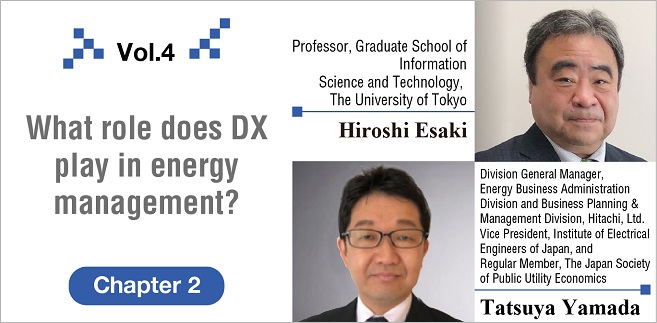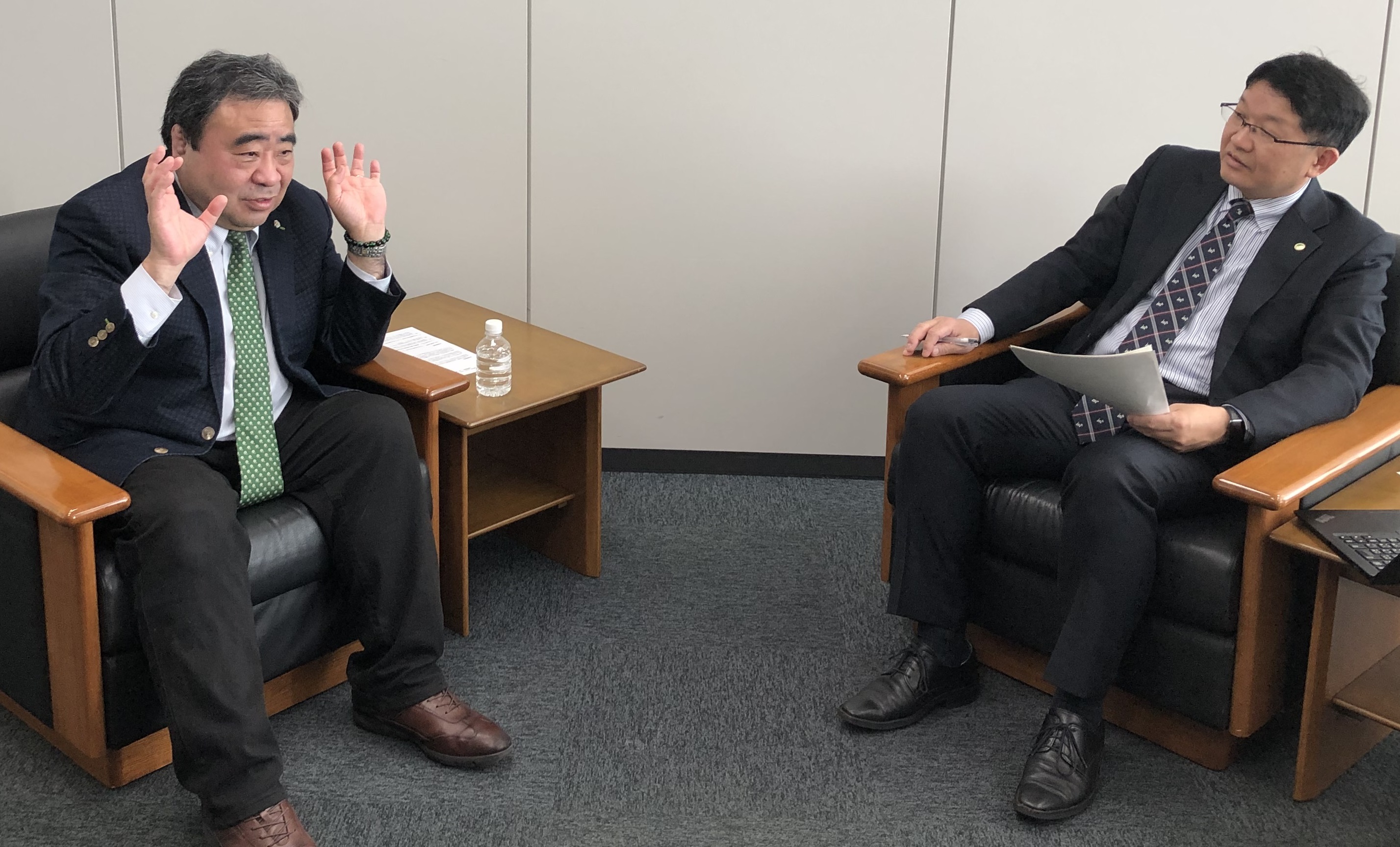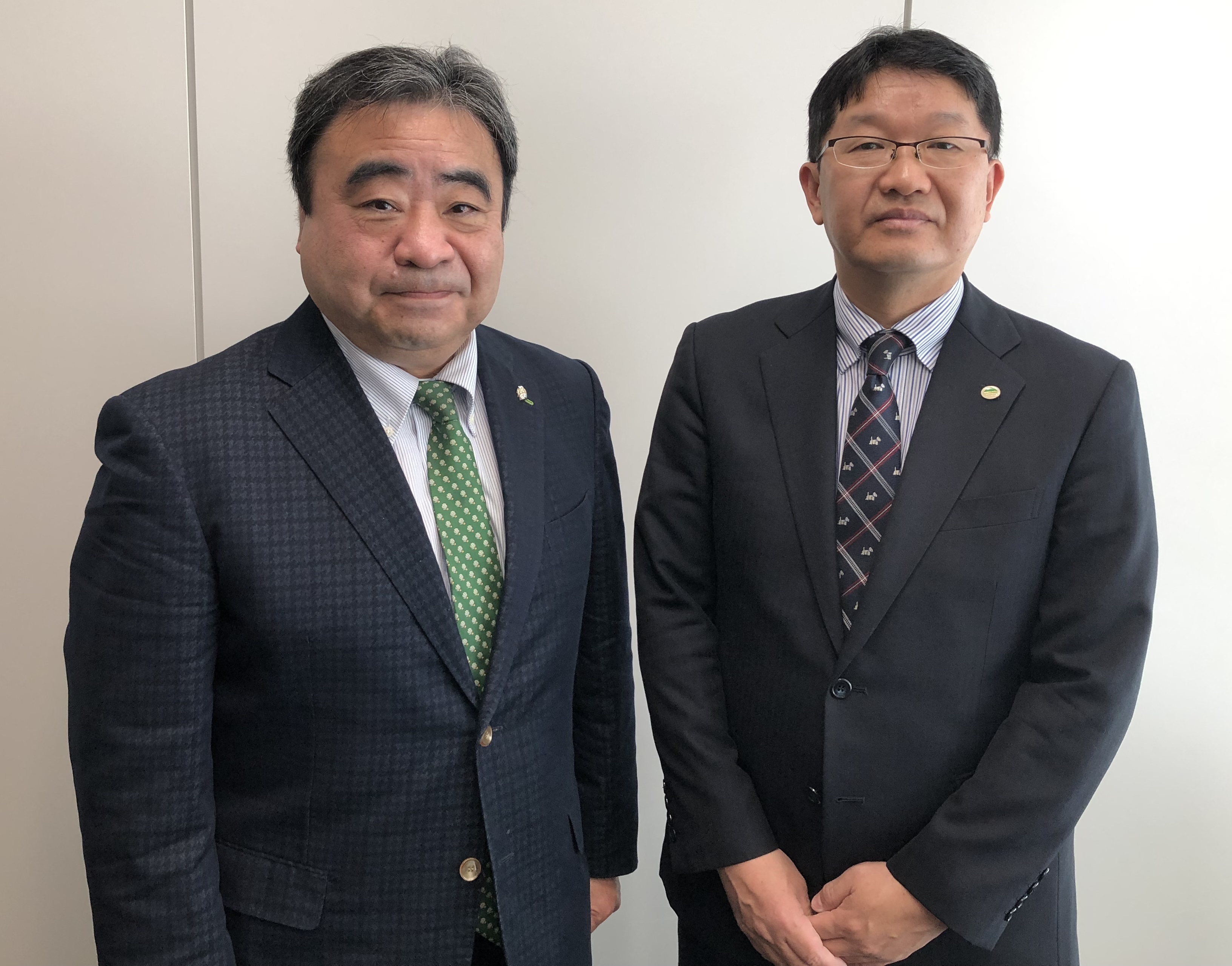
For this fourth volume of the series, we invited Hiroshi Esaki, a professor of the Graduate School of Information Science and Technology from the University of Tokyo who has been extensively involved in everything from research into smooth network utilization to policy recommendations as an information network expert. Professor Esaki is also driving the digital transformation of Japan as a senior expert at the Digital Agency. During this interview we talked about the key points for promoting the utilization of digital technologies that will accelerate energy innovation, the value that will be created, the future that will be brought, and other topics.

Yamada:In chapter 1, we heard about the future vision for regional energy management, and how the digitalization of energy management and data utilization are accelerating CN. I think data integrity will be one of the issues faced when implementing those technologies in society.
Esaki:How do you provide a free data distribution infrastructure with accessibility and trust? That is precisely what the late Prime Minister Abe proposed at the Davos forum in January 2019 with Data Free Flow with Trust, or DFFT. Creating an infrastructure for the free distribution of data, having people connected over a network being able to use that data and discover new value is an Internet approach, but we are now trying to do that with energy systems. Based on the DFFT approach, Japan's Digital Agency has presented a Government Interoperability Framework (GIF). This will enable the government and trusted institutions to create catalogs that describe rules for the structuring of data, and allow them to be referenced globally. The government will also provide an authentication service for that data and operators.
Yamada:Even if the integrity of data itself is guaranteed in that way, since the daily life of a household or production activities in an industry can be revealed based on energy data, confidentiality and privacy will also be called into question. What methods are available to deal with those concerns?
Esaki:There is more than ten years of research into the protection of privacy and anonymization, and the approach that has now emerged is the use of a federated learning system to learn off the data produced by each household or city, and share the training results. That method does not share individual data, but only the feature quantities obtained from the training process.
Yamada:Actually internally we have had discussions with people from other industry divisions about the possibility of a business utilizing data from smart meters. When we asked someone from a business division responsible for the finance industry about the value of the data from factory smart meters, we were told it could be possible to estimate the business performance or fluctuations in production for the company as the data could visualize the operating status of the factory, and we had the sense that the information could pertain to trade secrets. While we could say that the idea had potential to become a business, when we considered electricity consumption information being converted into information on corporate activities and financial information, we realized that the information would need to be handled carefully, including considerations about the methods for controlling it.
Esaki:As with the "Analects and the Abacus" principle advocated by Eiichi Shibusawa, it is important to strike a balance between economics and ethics. There is always a good side and bad side to any technology, and one of the conditions for becoming a trusted company is to strive to only use those good aspects, and to incorporate measures that prevent abuse into the business in advance. Similarly for the automated adjustment of electricity, a program should not be skewed to only favor one side. Hitachi's hesitation in this area is probably due to its sense of ethics. When I look into it thoroughly, what influences the trust in a business is the presence or absence of an ethnical perspective, and in the end I think humans are responsible for that parts pertaining to ethnics. I also think that is the way for Japanese companies to survive.
Yamada:Opening up data also poses issues for economic security. How is this being discussed from a policy perspective?
Esaki:Avoiding the open distribution of data and instead fortifying it at trusted companies offers greater reliability, but it would mean the data is locked up there. That is why together with the Ministry of Economy, Trade and Industry, we are currently considering a direction where data is distributed and made accessible globally, but with procedures in place to monitor who has accessed what data.
This is basically the same for energy systems. That's because if you don't make data accessible from anywhere, it will harder to respond when an accident occurs, and you also won't be able to run simulations for economic security. It is important that the integrity of the data distribution infrastructure is assured.
Additionally, when you think about energy optimization at the macro level, power systems being closed off by region as they are now becomes an issue. At the moment there are moves to develop offshore wind power generation in Hokkaido, but to achieve that it will become necessary to expand power systems on a nationwide scale.
I also think there is good potential for expanding those efforts globally. For example, we could relocate large domestic facilities that consume a lot of electricity to trusted countries achieving 100% renewable energy usage. Things that need real-time feedback would have to be in Tokyo, but for example a data center would not be problematic if back and forth communications took slightly longer, so it wouldn't necessarily need to be in Tokyo. By sorting facilities based on their intended use and other factors to distribute them globally, I think optimization at the global level can also be achieved.
Yamada:As a first step of that, there seems to be the idea of promoting decentralization within Japan. Placing a data center in a remote location and pursuing optimization is a change brought about by cloud computing. To take that further and achieve CN, a relaxing of regulations and changes to corporate-side behavior will be needed. With regard to distributing the locations of data centers globally, we first have to considers the risk taking involved with exchanging data outside the country.
Esaki:Under current circumstances it would be difficult to place the systems of one country in another country, but we are now started to see some facilities that had been concentrated in the Kanto region dispersed into the Kansai region. Next would be to further disperse the locations to Hokkaido and Kyushu, and thinking about overseas locations would be the step after that. And then the issue of economic security emerges. At this time, the issues would be whether the country's policies and a company's policies are the same or different, or how another country would cooperate. Particularly in the case of energy as a physical resource, even if you build power systems in Japan, you need the rare earth materials to run them or you won't get anywhere. That is why it is necessary to think about policy and businesses from a global, comprehensive perspective.

Esaki:This discussion is titled "Initiatives for the Achievement of CN," but to achieve that, I think EP100 (100% energy productivity: increasing the energy efficiency of business) should be pursued instead of RE100 (100% renewable energy use). EP is not simply about turning off lights; it's an approach to switching from fluorescent to LED, and balancing energy conservation activities with improvements to the brightness of the workplace environment. Just like with cloud computing, migrating to the cloud improves security while reducing maintenance and personnel expenses, and it can also bring us closer to CN. I think that is where the incentive for a company to pursue CN lies.
Yamada:To pursue energy management on the consumer side on a widespread scale, I think a DX-based distributed energy platform is needed, but that possesses difficulties as long as it is not an industry.
Esaki:While the same goes for Hitachi, historically the supply of power has started from private generation by companies. Some of them formed electric power companies and were industrialized, and before the war, the industry was placed under government control. After the war, the industry was broken up again. In this way, all industries undergo a cycle of concentration and dispersion while reflecting social conditions, and during that process the structure of industry changes significantly. Take the automotive industry, for example. Recently a growing number of people are utilizing car sharing services instead of buying their own car. In the future, as sharing evolves in various industries, who will buy physical assets, and how will we create cash flow? I think every industry will experience drastic changes that differ from the past.
The way to prevent this ends up being segmentation, in other words closing off a company or industry. First, I think it is crucially important to visualize the available resources and share them with everyone.
Yamada:The sharing economy you described is an innovation only possible thanks to digital technologies.
Esaki:Digital technology is a precondition for sharing, and sharing actually leads to CN. For example, newspaper companies have long maintained printing facilities and distribution systems in-house, but now articles can be read over the Internet, and because they are shared digitally, these companies have downsized their printing facilities and distribution systems, and drastically cut investments in hardware. In the shipping industry, the COVID-19 pandemic caused shortages in cargo capacity, but the practice of sharing through the pooled use of cargo space contributed to CN and also increased profit margins.
The same goes for PCs. Software has given us the ability to convert digital information in various ways. What used to be done with multiple pieces of hardware can now be accomplished with a single computer. This contributes to CN in extremely big ways when you think about the supply chain overall. In short, utilizing digital technologies to create a sharing economy is an extremely important initiatives in raising EP.
Yamada:While there are things that can be eliminated through digitalization, there are some physical things that will never go away. Hitachi is creating just such things, in the form of energy and power plants, but in the future, how will these values be perceived?
Esaki:As DX requires computers and electricity, there is a great deal of value to possessing hardware assets. GAFA has also realized this, and in recent years it has started to invest in physical assets such as data centers and power plants.
Another significant source of value is in providing energy in a stable way in addition to it being clean energy. In 2021, when China regulated blockchain, blockchain mining machines were relocated to another country, but power outages occurred due to insufficient power in that country. In other words, strong components that can guarantee the mining business are contingent upon modern electric power assets.
Yamada:In the course of these varied discussions we had today, I was reminded of how important it is to use digital technologies in smart ways to improve utilization rates, to use energy and resources in efficient ways, and of how creating value and increasing profitability is key.
Esaki:In the end, what's important is evidence-based policy making (EBPM). Digital technologies are a powerful force for understanding that current situation. In every industry, we are experiencing fundamental changes to the way we work due to digital technologies, and we need to understand that now humans can focus on the work they are supposed to be done. If efficiency does not improve even after digitalization, it is probably because those tools are not being used in the right way. Even if you have a good system, no one will use it if the UI or UX are poor. We have to create interfaces based on users' needs, as this will lead to efficiency improvements. That is that essence of DX.
Yamada:From discussions about policy to the potential of new energy management and key points in the promotion of DX and GX, I think we were able to gain some insight into the future through a wide range of thought-provoking topics. Thank you very much for your time today.

Hiroshi Esaki
Completed master's program in the Department of Electrical Engineering and Computer Science, School of Engineering at Kyushu University in 1987. Joined Toshiba in April of that year. Spent two years from 1990 at Bellcore Inc. in New Jersey (USA) and two years from 1994 at Columbia University in New York (USA) as a visiting scientist. Associate professor at the Computer Center of the University of Tokyo since October 1998, and at the Graduate School of Information Science and Technology since April 2001. Professor at the Graduate School of Information Science and Technology since April 2005 (current position). Representative of the WIDE Project. Representative of MPLS-JAPAN, Senior Director of the IPv6 Promotion Council, President of JPNIC, Director of the Japan Data Center Council and Chairperson of its Steering Committee, concurrently serving as Chief Architect (now Senior Expert) at the Digital Agency from September 2021 Doctor of Philosophy (the University of Tokyo).
Tatsuya Yamada
Division General Manager, Energy Business Administration Division and Business Planning & Strategy Division, Hitachi, Ltd.
Vice President, Institute of Electrical Engineers of Japan, and Regular Member, The Japan Society of Public Utility Economics.
Tatsuya Yamada joined Hokuriku Electric Power Company in 1987, and was seconded to The Institute of Energy Economics, Japan in 1998 before joining Hitachi, Ltd in 2002.
He has engaged in tasks involved in the planning of strategies for energy-related businesses, and became Director of the Management Planning Office, the Strategy Planning Division in 2014, Senior Manager of the Business Planning Division, the Energy Solution Business Unit in 2016, General Manager of the Business Planning Division, the New Age Energy Business Co-create Division in 2019, and assumed his present positions in 2020.